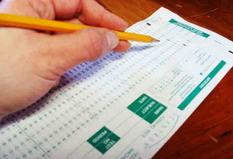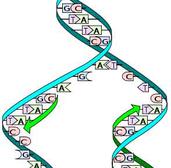 | ||||
Molcular Genetics: Replication
Practice Test Questions
from Science Prof Online
 | ||||
Free review questions to help students better understand
DNA Replication Sample Test Questions
 | ||||||
SPO VIRTUAL CLASSROOMS
1. Which is true about the pairing of bases in the DNA molecule?
a. purines always pair with pyrimidines
b. a single ring base pairs with another single ring base
c. a double ring base pairs with another double ring base
d. purines pair with purines and pyrimidines with pyrimidines
2. If this is the base sequence of a strand of DNA (A T G C C T), what would be the base sequence of the complimentary DNA strand?
a. T A C G G A
b. A T G C C T
c. U A C G G A
d. A U G C C U
e. D O N T N O
3. Where does replication occur in eukaryotic cells?
a. wherever there is DNA
b. only in the nucleus
c. only in the ribosome
d. only in the mitochondria
4. Replication is when...
a. proteins are made
b. RNA is made from the DNA template
c. another copy of DNA is made
d. DNA is made from the RNA template
5. DNA is an organic polymer (a big molecule) composed of monomers (building blocks) called…
a. amino acids
e. peptides
6. Where does the energy come from for DNA polymerization?
a. ATP
b. the sugar energy of the new nucleotide
c. breaking of a phosphate bond from the new nucleotide
d. ADP
The following questions are designed to help students better understand this topic. All questions are based on material that can be found on the Molecular Genetics: Replication Lecture Main Page.
Page last updated: 2/2016
 | ||||
Science Prof Online
has several
Virtual Classrooms
including:
(15 weeks)
(8 weeks)
(8-weeks)
(16 weeks)
WHICH GENETIC TRAITS DO YOU HAVE?
7. The fact that DNA is "antiparallel" means that...
a. one strand is perpendicular to another
b. that each of the strands are exactly the same as each other
c. that the 2 strands are each constructed in opposite directions
d. that the strands are mirror images of each other
8. Where along the parent DNA strand does synthesis of the new DNA strand take place?
a. outside of the replication bubbles
b. at the forks of the replication bubbles
c. forks are used to pop the replication bubbles
d. only in areas were the DNA is "zipped up"
9. Each nucleotide monomer is composed of...
a. a sugar, one or more phosphate groups and a base
b. a base amino group, acidic carboxyl group and a hydrogen atom
c. amino acids
e. DNA
10. The chromosome of a prokaryote is called a...





